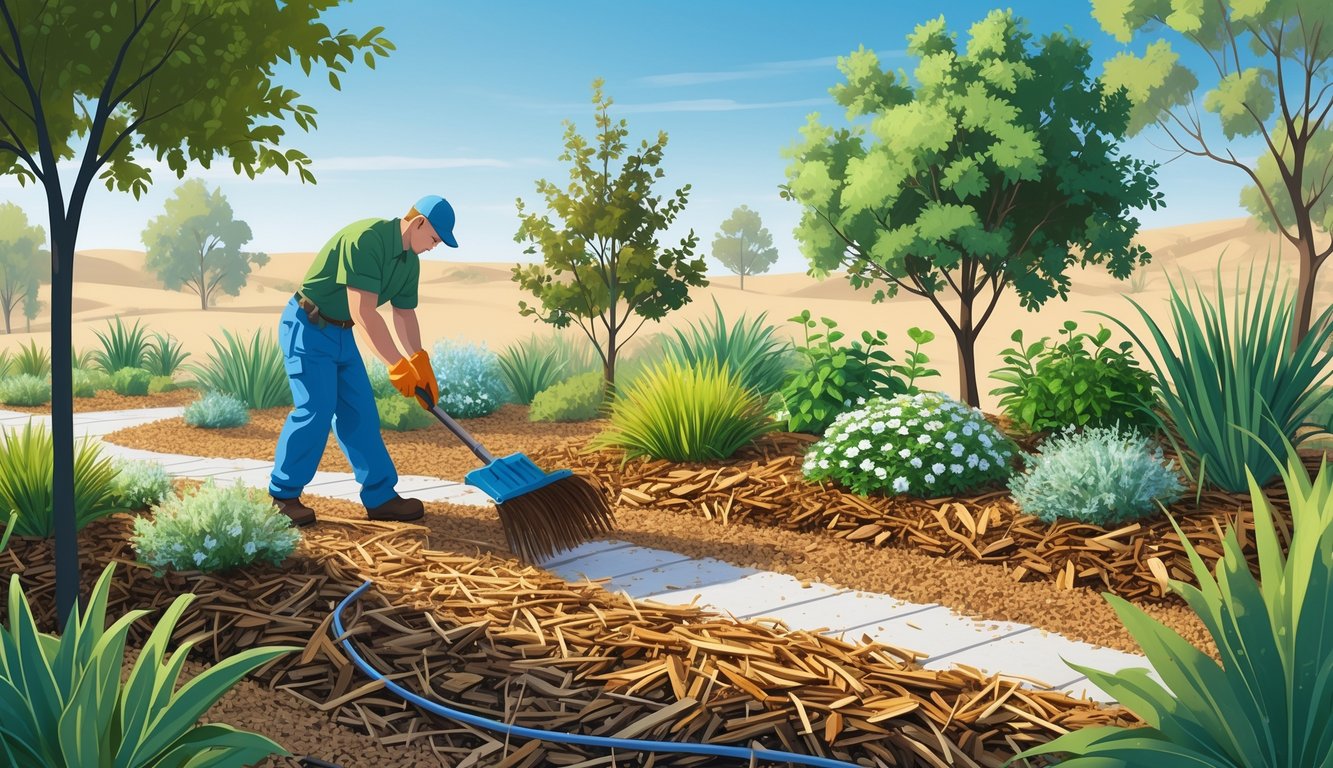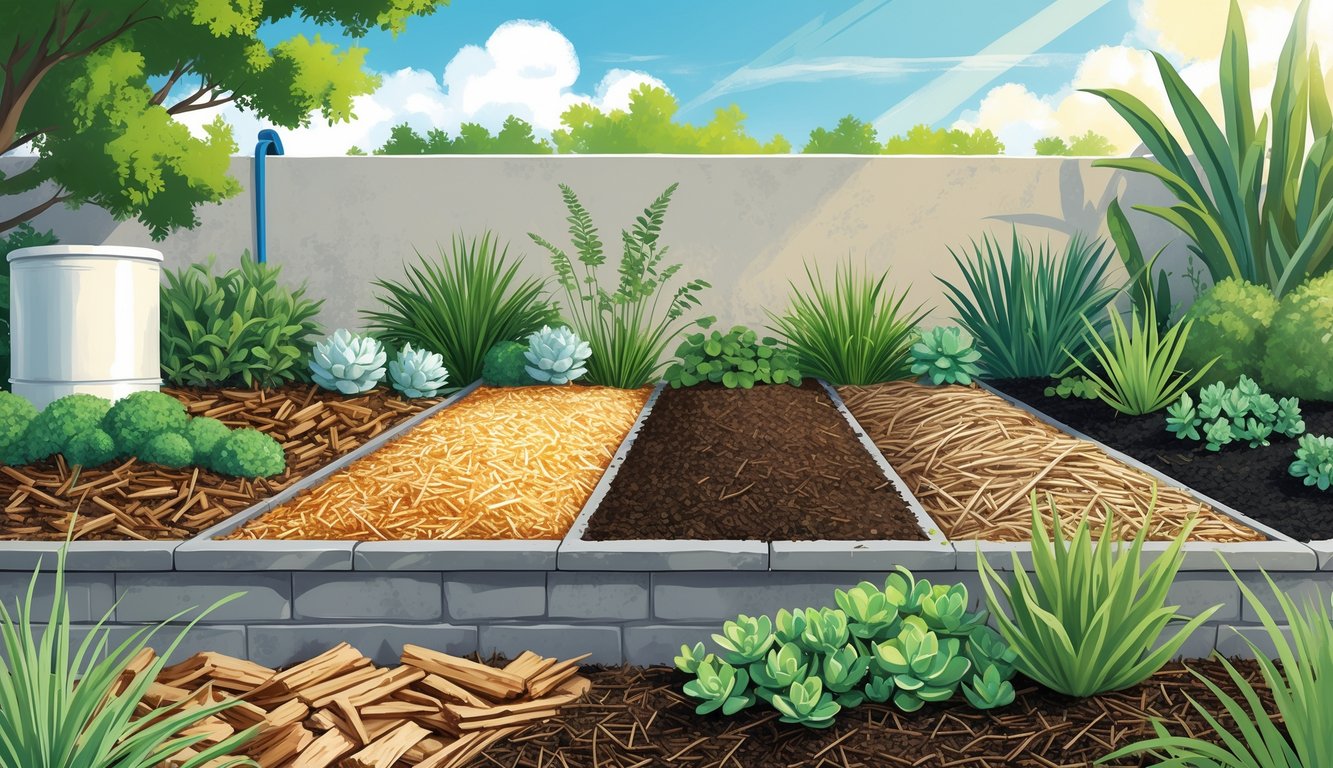
Popular Types of Eco-Friendly Mulches

Every year there’s a new “miracle” mulch at the nursery, but drought-proofing the soil isn’t optional anymore. I’ve seen pros ruin a job with the wrong stuff, and “organic” means nothing if you pick the wrong type.
Organic Mulches for Sustainable Land Management
People ignore leaf mold—guess they think rotten leaves are garbage. Not true. Gardening Know How says oak leaves make a killer (if temporary) weed barrier and moisture blanket. Bagging leaves feels like a crime after you see what they do for soil. Compost mulch is unpredictable; some clients swear by it for tomatoes—crazy growth after just one season.
Wood chips look tidy, but nobody warns you: over 3 inches deep and you suffocate roots, trap fungus—ask an actual landscaper, not the garden center cashier. Straw mulch? Last resort, honestly. It keeps soil cool but attracts rodents and breaks down too fast for real drought help.
Organic mulch (compost, wood chips, straw) breaks down and feeds the soil—but only if you stay on top of it after storms or heavy foot traffic. Mix bark types by accident and you’ll be fighting weeds in weird places. Ask me how I know.
Living Mulch and Cover Crops
Why bother with living mulch when grass seed is cheap? Here’s why: cover crops like crimson clover or winter rye actually hold in moisture where regular mulch fails. Cornell found clover keeps 30% more moisture than bare dirt. Free irrigation, basically.
My neighbor let white clover take over between squash beds—no soil crust, bees everywhere. But if you pick the wrong cover crop, you’ll be fighting a jungle or a mud pit. Nobody warned me about buckwheat self-seeding for years. Oops.
Living mulch isn’t a cure-all. Sure, it’s green, but mix up clover and vetch and your garden smells like peas. High-nitrogen fixers help, but you still need to weed (sorry). Experts say mowing is better than tilling, and I agree, though the rabbits think I’m running a buffet.
Inorganic Mulches: Stone, Gravel, and More
Stone mulch? Yeah, it’s heavy. All those HGTV shows act like you just toss a bag and it’s instant curb appeal—sure, if you’ve got a forklift and a personal chiropractor. Dragging gravel around in the middle of a heatwave? I’d rather dig up the whole yard and start over. But, okay, once it’s down, you mostly forget about it. According to Gecko Green’s mulch types guide, it’s supposed to be a smart move if you’re somewhere bone-dry, but honestly, it feels like a gamble. It doesn’t rot, it doesn’t feed the soil, and if you pick black rock—congrats, you’ve built a backyard oven.
I tried pea gravel in my own dry beds. It drains well, blocks most weeds, and you can walk on it barefoot if you’re feeling brave, but my dog gives me that look every time. Here’s the thing—rain just skips off, and if you pile it on too thick, you’re basically declaring war on anything with roots. Succulents? Sure. Everything else? Good luck. People love weed barriers under stone, but nobody tells you about the microplastic confetti that shows up later. Landscape fabric is a scam, sorry.
Looks-wise, rocks stay pretty. But then—broken glass, roots jammed tight after a decade, and you’re out there with a shop-vac picking gravel out of your daylilies. “Gravel drift,” some guy called it at a conference. I thought he was exaggerating. He wasn’t. Inorganic mulch is for folks who want to forget mulch exists, but unless you’re landscaping a parking lot, it’s never that simple.
Selecting the Right Mulch for Drought Control

Why is mulch such a battleground? Everyone’s got a theory—somebody’s always claiming their secret recipe will resurrect a dead yard or save gallons of water. Soil texture, plant origin, every weird environmental ripple—there’s no “one size fits all” answer, and anyone who says otherwise is selling something. Bark, compost, pine straw, leaves—honestly, it’s a rabbit hole. And yeah, the research says mulch choices can make or break drought resistance, but who’s got time to read footnotes?
Assessing Site and Soil Conditions
I keep poking at my soil, hoping for a dramatic pH plot twist or some buried treasure. Usually, it’s just clay, or sand, or whatever, and if you skip the basics—like, is your soil so compacted you need a jackhammer, is it bone dry, does it even have organic matter?—mulch won’t save you. Universal mulch? Doesn’t exist. It just sits there, looking pretty.
It drives me nuts when every “expert” says “just use organic mulch!” but skips the part about checking your soil’s mineral content or whether it even holds water. Dumping three inches of pine bark on top of lifeless dirt? You’ll just get dry bark. Soil health actually matters. Compost or shredded leaves? Now you’re talking—more water sticks around, microbes get a shot. But, yeah, sometimes you need a soil test. I do it more than I want to admit. No mulch fixes a trainwreck pH.
Story time—one summer, I layered hardwood chips on alkaline clay. Every drop of water vanished before noon, nothing grew. But in the one strip where I’d bothered with compost? Plants didn’t even flinch. Sometimes I think the shovel knows more than the gardening magazines.
Matching Mulch Types with Native Plants
I’m low-key obsessed with matching mulch to what the plants actually want. Oaks? Don’t drown them in bark nuggets. Sages? They just want to be left alone, maybe some leaf litter. The city loves pushing pine straw and chipped pallets, but ever seen azaleas gasping under black-dyed mulch? I have. It’s tragic.
Half the landscapers around here haul in cypress chips because they “last longer.” True, but they also smother everything delicate and mess with the soil’s organic balance, especially when you need fast moisture fixes. Want my take? Organic mulch—bark, leaves, even lawn clippings if you’re not spraying chemicals—usually keeps native perennials happy. Big wood chunks? Sometimes they just trap humidity and rot things out, especially desert wildflowers.
Why plant drought-tolerant natives and then smother them with thick commercial mulch? I’ll never get it. Compost mulch breaks down fast—fine by me, keeps my soil’s pH steady and means less work. Sometimes, just watching and adding less mulch does more for drought-resistance than any fancy product.
Considering Climate and Environmental Impact
Everyone loves to say “climate” like it’s a magic word, but nobody actually explains what that means for mulch. I’ve tried wood chips and bark for dry spells, but in places where the weather’s a circus, even the “eco-friendly” stuff can go sideways if you slap it on wrong. Pine straw’s great for acid-loving shrubs, but in my neutral beds, it’s just for looks.
Environmental impact? My neighbors brag about “local mulch,” but one guy brought in rubber chunks because “it never breaks down.” That’s not helping—roots suffocate, soil bakes, nothing gets fed. Sustainability? Check where your mulch comes from and how fast it breaks down. I use composted city leaves when I can. It feeds the soil, and I feel slightly less guilty watching it turn to dirt.
Bottom line, mulch isn’t a set-and-forget thing, and every choice you make sets off weird environmental dominoes, especially in drought gardens where every saved drop feels like a miracle—or at least a reason not to cover everything in gravel.